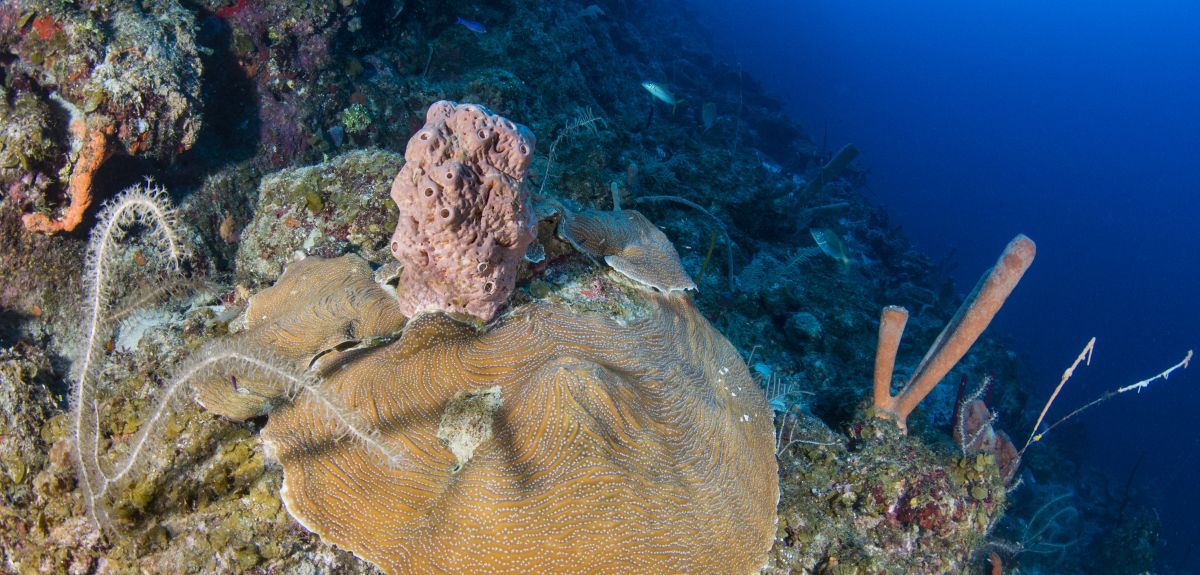
Image credit: Ally McDowell
Entering the 'twilight zone': could distant coral reefs provide a refuge for threatened aquatic species?
Most of us will be at least vaguely aware that our planet's coral reefs are in jeopardy. But why are they in danger, and what can we do about these threats?
A new report by the United Nations Environment Programme (UNEP) has set out to provide a health check for a particular type of underwater ecosystem known as mesophotic coral reefs. Mesophotic reefs are found deeper in tropical and subtropical waters than the shallower reefs we may be more familiar with. And, according to the report, these ecosystems may be able to act as 'lifeboats' for threatened species living in shallower reefs.
Two DPhil students in Oxford's Department of Zoology, Jack Laverick and Dominic Andradi-Brown, co-authored a chapter of the report examining the threats facing mesophotic reefs. They spoke to Science Blog about the diving expeditions that allowed them to identify the dangers posed to these fragile ecosystems – large, underwater structures composed of the hard, calcium carbonate 'skeletons' of coral, a marine invertebrate.
Dominic, who also sat on the steering group for the report, explained: 'Our research on mesophotic coral ecosystems took us to Honduras and Indonesia. At first glance the mesophotic reefs look similar to shallow reefs – we see many similar species and groups, including corals, sponges and algae. However, when you look a little more closely you see that many of these species and groups have taken on slightly different forms. For example, corals tend to be flatter, while sea fans tend to be larger.
'During the course of our research we spotted many species of fish at depth that are threatened in shallower waters. In September 2015 in Honduras we observed Caribbean reef sharks at depths of 60m, whereas these sharks are near-absent from shallow reefs because of historically high levels of shark fishing.'
Jack said: 'Mesophotic coral ecosystems are quite different to the shallow reefs many people are aware of. We say these reefs are found in the "twilight zone", as light fades exponentially with increasing depth. Amazingly, despite it being barely light enough for us to see when we visit the deepest extents of these coral reefs, hard corals are still able to photosynthesise.
'To get around the lack of light energy, hard corals become increasingly flat and fragile, capturing the most light energy possible for the smallest amount of growth. These discs can stack in a shingle-like pattern, casting a very different scene to what is commonly seen near the surface.
'Our work is scheduled extremely tightly when we visit these ecosystems, leaving little time to enjoy being on the reefs. Despite this, working in the twilight zone has us convinced that mesophotic coral ecosystems require their own protection – as a potential store of shallow reef species, for the services they provide, and for their own haunting beauty.'
In his foreword to the report, outgoing UNEP Executive Director Achim Steiner (who will be taking up a post at Oxford University's Oxford Martin School) points out that almost a fifth of coral reefs have disappeared thanks to human activity, with a further 35% expected to be lost in the next 40 years – unless we act now.
He adds: 'Coral reefs provide both tangible and intangible benefits to the lives of millions of people. From providing food and income to protecting our coasts from damaging storms, coral reefs make an incalculable contribution to coastal communities, as well as to the organisms that depend on them.'
But while mesophotic coral reefs may provide a lifeline for some of the shallow-reef organisms threatened by human activity, they also face threats of their own.
Dominic explained: 'One example of a major threat that we're studying here in Oxford is invasive lionfish in the Caribbean. Lionfish were introduced to the Caribbean from the Indian and Pacific Oceans and have rapidly spread across the region. During our research we've observed them deeper than 100m, where they feed on native reef fish, causing knock-on effects throughout mesophotic ecosystems.
'Current control measures are focused on culling, with divers removing individual lionfish from the reef. However, this is normally limited to depths shallower than 30m, which is the normal limit for scuba divers. Our work highlights the importance of considering the role of deeper reefs in management plans for lionfish control.'
Both Jack and Dominic emphasise the importance of the report – and of acting on it.
Jack said: 'This report is a major step forward in highlighting the existence of these deep reefs, which many people have never heard about. As we find ourselves in the midst of the third global coral-bleaching event – when warmer water temperatures result in coral losing their algae – it is important that people are made aware that these extensive reefs exist; reefs that could help stave off a global disaster by storing species for future regeneration of shallow ecosystems. We might have a lifeline for coral reefs globally, and we must not waste this resource.'
Dominic added: 'Mesophotic reefs are little explored, yet this report highlights that they may have a crucial role to play in helping maintain healthy coral reefs in the face of current and future reef threats. But despite the added protection they have from being deeper, this doesn't mean they are immune to damage.'